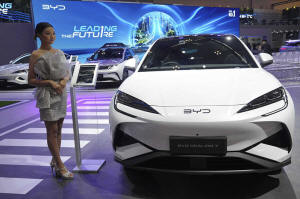Indonesia's clean energy future is at the center of a supply struggle
between the US and China
[September 23, 2025] By
ANIRUDDHA GHOSAL
The race to replace coal in Indonesia, the world’s largest coal
exporter, has become a contest between the U.S. and China. At stake is
not only Indonesia’s climate future, but also which superpower sets the
terms for the next generation of energy in the developing world.
Like much of the developing world, Indonesia faces a choice between two
stark energy futures.
Chinese companies signed more than $54 billion in agreements in 2023
with Indonesian state utility PLN, while Indonesian President Prabowo
Subianto’s 2024 Beijing visit added $10 billion in commitments. Chinese
firms are now rapidly embedding themselves in Indonesia’s clean-energy
supply chain, from solar and critical mineral mining to electric
vehicles, also known as EVs.
These investments dwarf the $20 billion Just Energy Transition
Partnership, or JETP, signed in 2022 between Indonesia and a group of
wealthy nations to help the country shift away from coal, which
contributes 3.6% of the country’s GDP.
The program was faltering even before U.S. President Donald Trump's
administration formally withdrew in March. Only $1.2 billion, or about
6%, of JETP finances have been disbursed while Indonesia believes it
needs over $97 billion for the transition.
The U.S. is the world’s top oil producer and has pushed liquefied
natural gas, or LNG, as part of talks meant to head off tariffs for
Indonesia. It touts “energy dominance” as a way to cut dependence on
rivals like China. Beijing is betting on big renewables to cement its
role as the biggest supplier of clean energy technology.

The U.S. path risks deeper fossil fuel dependence, while China’s
promises jobs and cleaner power with fewer safeguards.
“These two countries ... they’re shaping two different visions of the
future,” Putra Adhiguna of the Energy Shift Institute said.
U.S. exit impacts politics but not investment
The U.S. withdrawal in March didn’t derail the JETP, but impacted
political leadership, analysts said.
When the deal was signed, U.S. climate envoy John Kerry said America had
laid the groundwork. But after Trump dismantled Biden-era climate
policies and pushed fossil fuel development, Indonesian officials
questioned why they should transition if America isn’t, Adhiguna said.
Early JETP conversations “set expectations unrealistically high,”
raising goals that were hard to achieve regardless of U.S. policy
changes, he added.
The U.S. pledged $2 billion, with roughly half still accessible via loan
guarantees, said Jordan Lee of the Tony Blair Institute for Global
Change in Jakarta. The JETP always was meant to cover only a portion of
the roughly $97 billion needed. Foreign investment was critical given
Indonesia’s tiny solar and wind sector, accounting for 0.24% of total
energy compared with 3.8% in the Philippines and 13% in Vietnam.
Lee said the JETP also provided a unifying platform for stakeholders and
helped Indonesia partner with new countries like the UAE and Saudi
Arabia.
Indonesia's JETP secretariat didn’t respond to a request for comment
from The Associated Press.
China offers a new model
China offers a "different version of energy security," replacing
imported fossil fuels with solar panels that generate electricity for
decades, Adhiguna said.

[to top of second column] |

A model stands near a Sealion 7, an electric vehicle from Chinese
automaker BYD, during the Gaikindo Indonesia International Auto Show
in Tangerang, Indonesia, Wednesday, July 23, 2025. (AP Photo/Tatan
Syuflana, File)
 Major Chinese projects in Indonesia
include a $6 billion supply-chain venture by battery giant CATL with
local partners in 2022 and BYD’s $1 billion EV plant announced in
2024 will produce 150,000 cars annually and employ 18,000 workers.
China's BTR New Material Group launched a $478 million factory in
2024 that will make anode materials for EV batteries and create
around 8,000 jobs, while a solar panel factory unveiled in 2025 by
LONGi has an annual capacity of 1.6 gigawatts.
“It’s a whole-systems change,” said Dinita Setyawati, an energy
analyst focused on Southeast Asia at the think tank Ember. She noted
this meant a country could buy solar panels from China and charge
their Chinese-built electric cars with clean electricity.
These projects are deployed quickly, which is crucial for
Indonesia’s five-year political cycles, even if Western investors
offer more safeguards. POWERCHINA built a 100-megawatt solar park in
just seven months in 2024.
“If a U.S. company takes four years to do a feasibility study,
Chinese companies will already have invested by then,” Adhiguna
said.
But Chinese investments often have come with high environmental
costs.
Most of Indonesia’s nickel mines, for instance, are Chinese-owned.
The country has the biggest reserves of the mineral needed to build
EV batteries and the mines rely on captive coal-fired power plants,
built on-site to supply electricity.
A 2024 study by the Centre for Research on Energy and Clean Air on
the impact of nickel mining in three Indonesian provinces found
pollution from smelters and the coal-fired power plants would cost
the economy $2.6 billion in 2025, rising to $3.4 billion by 2030,
while resulting in more than 3,800 deaths in 2025 and nearly 5,000
by 2030.

US gas could lock Indonesia into fossil fuels
Indonesia’s energy minister, Bahlil Lahadalia, said in April it
would boost LNG imports from the U.S. by around $10 billion as part
of tariff negotiations. LNG is natural gas cooled to liquid for
storage and transport, burning cleaner than coal but still emitting
greenhouse gases.
The risk is that the gas deals could further entrench Indonesia’s
reliance on fossil fuels. Committing to long-term deals risks
leaving countries stuck with outdated infrastructure, even as the
world moves quickly toward cheaper, faster-to-deploy solar and wind
power, analysts said.
Indonesia could risk falling behind in the clean energy transition
and miss out on investment opportunities, such as data centers
seeking renewable energy in Southeast Asia, Setyawati said.
“And once they realize it, it might be too late,” she said.
Meanwhile, Indonesia remains deeply tied to coal. It was the only
country to propose building new coal plants and had the
third-highest amount of coal capacity globally in 2024. About 80% of
the 1.9 gigawatts of coal capacity Indonesia built was for the
captive coal plants for smelters processing minerals like nickel and
cobalt for electric vehicles, according to a report by U.S.-based
nonprofit Global Energy Monitor.
“The Indonesian government needs to realize that this is where the
world is heading, like it or not,” Setyawati said.
All contents © copyright 2025 Associated Press. All rights reserved |